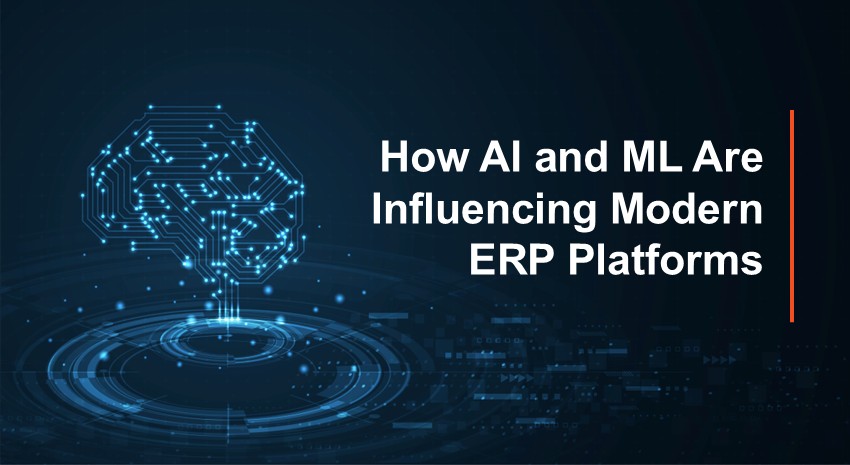How AI-Enabled ERPs Help Companies Increase Efficiency and Remain Competitive

Enterprise Resource Planning (ERP) systems have long served as the digital backbone of complex organizations, centralizing data, standardizing processes, and supporting informed decision-making across finance, sales, operations, supply chain management, and other key areas. In recent years, Artificial Intelligence (AI) and Machine Learning (ML) technologies have been transforming modern ERP platforms, enabling businesses to scale, automate, and innovate more effectively.
Redefining ERP efficiency
Traditional ERP workflows have often relied heavily on human input, particularly in areas such as finance, procurement, and supply chain management. Tasks including invoice entry, order processing, inventory updates, and financial reconciliations can be repetitive and error-prone when performed manually.
AI capabilities enable ERP platforms to automate many of these tedious, manual tasks. Machine learning models in ERP can extract data from invoices, validate entries, detect duplicates, and initiate approvals based on learned business rules.
Bank reconciliation—once a time-consuming activity—can now be mostly automated. For example, Microsoft Dynamics 365 Business Central utilizes machine learning to intelligently match bank statement entries to general ledger transactions, learning from corrections over time and improving accuracy with each reconciliation cycle.
This automation dramatically reduces cycle time and labor costs while ensuring greater accuracy. For finance teams, this means fewer manual journal entries and faster month-end closings, freeing up resources for strategic analysis rather than data entry.
Predictive and prescriptive ERP insights
Where traditional systems provide historical reporting, modern, AI-enabled ERP platforms help businesses anticipate future outcomes and suggest optimal actions through predictive and prescriptive analytics within ERP environments.
ERP AI can analyze historical sales patterns, supplier performance, and external market indicators to forecast product demand more accurately for manufacturing companies facing fluctuating demand and volatile supply chains. It can also recommend adjustments to procurement schedules, staffing levels, and production plans. By simulating various scenarios and identifying likely outcomes, AI empowers users to make proactive decisions rather than reactive corrections.
Finance departments are also seeing benefits from integrated AI in their ERP systems. AI models can project cash flow under various conditions, identify invoices at risk of delay, and optimize working capital management based on real-time inputs.
Inventory management also benefits from AI and machine learning in ERP. For instance, AI-enabled ERPs can recommend stock replenishment based on historical consumption, lead times, and sales trends. Rather than simply reordering based on static reorder points, the system adapts to seasonal patterns and supplier behavior, thereby reducing stockouts and excess inventory.
Natural language and Copilot integration
ERP systems have historically suffered from usability challenges. Complex navigation, rigid menus, and nonintuitive user interfaces have often limited adoption to a few trained users. AI is changing that by introducing natural language interfaces, customizable dashboards, and conversational assistants that allow employees to interact with ERP systems as they would with a colleague.
For example, a user can type: “Show me revenue by region for last quarter” and receive an AI-generated summary with visuals and insights, along with a detailed visual report. This dramatically increases accessibility across departments and reduces reliance on development staff or Excel power users to extract insights.
Adaptive workflows that respond in real time
AI enables ERP systems to become more adaptive, allowing them to respond to new data and conditions in real time. In traditional systems, workflows are often static and hardcoded, requiring manual reconfiguration when business rules change. AI-driven ERP platforms can respond dynamically based on context and behavior.
In a warehouse setting, for instance, if an unexpected spike in demand causes inventory shortages, the ERP system can automatically trigger reorders, reroute shipments, or prioritize high-value customers for fulfillment. In finance, AI can dynamically reassign expense approvals or reroute workflows if an anomaly is detected in a transaction.
These self-adjusting processes relieve staff of tedious manual tasks and help organizations stay agile and resilient.
Risk detection and compliance
Machine learning also plays an increasing role in helping organizations manage risk and maintain compliance. AI-enabled tools can continuously monitor transactional and behavioral patterns to flag anomalies, detect fraud, and ensure adherence to corporate governance.
This is especially important in sectors such as banking, insurance, healthcare, and government, which have strict regulatory requirements and significant penalties for non-compliance. ERP systems enhanced with AI can help to minimize risk by identifying unusual payment activity, data access anomalies, or inconsistencies in expense claims, often well before human reviewers would catch them.
AI can also track regulatory changes and update compliance workflows accordingly, ensuring that internal controls remain up to date without requiring constant manual intervention.
Personalized experiences and role-based recommendations
Tailored experiences help drive greater user adoption, faster decision-making, and increased productivity. AI enables ERP platforms to deliver personalized dashboards, recommendations, and alerts based on a user’s role, activity, and preferences.
These ERPs support personalizing the user experience based on role centers. Dashboards can be tailored to a user’s responsibilities so a user can monitor what is most important to them. For example, a warehouse manager might track real-time inbound shipments and anomalies in bin content, while the CFO monitors KPIs related to cash flow, profitability, and budgets.
Over time, these dashboards evolve, highlighting what matters most without requiring the user to configure complex queries.
A system that continues to learn and improve
Unlike legacy systems that remain static until the next upgrade, AI-enabled ERPs continue to evolve. AI models improve as users correct predictions, revise forecasts, or override recommendations. The more the system is used, the more intelligent and responsive it becomes.
For example, if a company repeatedly adjusts forecasted demand for a seasonal product, the system will learn and adapt future suggestions. Over time, its demand planning becomes more accurate, improving customer satisfaction and saving money through more precise forecasting.
Data quantity, quality, and privacy
AI and ML work by consuming and analyzing vast amounts of data in order to learn and derive meaningful conclusions. Data collection and analysis is a significant job in itself and involves:
Data collection – The data used typically comes from multiple sources. This means the data must be collected, have duplicate entries removed, and be formatted properly before the system can ingest the information for analysis.
Data accuracy—Bad data leads to bad results. For maximum accuracy, it is important that all data used for AI and ML applications be accurate and unbiased.
Data Privacy – Data privacy is under increased scrutiny these days. Companies must remain aware of local, national, and international data protection and privacy regulations, particularly when using sensitive customer or vendor information, to avoid legal or ethical problems.
Learn what an AI-enabled ERP can do for you
AI-enhanced ERP platforms are helping businesses be more strategic, agile, and competitive. Microsoft Dynamics 365 Business Central exemplifies how AI is helping modern ERP systems enable companies to streamline operations, make informed decisions, and proactively adapt to change.
Whether you’re struggling with manual financial processes, reactive inventory planning, or inadequate reporting, contact the experts at ArcherPoint by Cherry Bekaert to help you fully utilize Business Central’s intelligent capabilities.
Trending Posts
Stay Informed
Choose Your Preferences
"*required" indicates required fields
